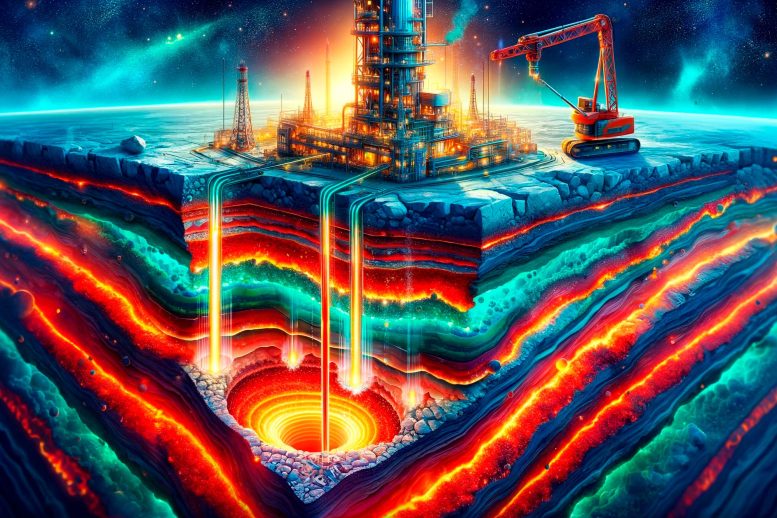The Game-Changing Superhot Energy Source Lying Deep Underground

The Geothermal Rising Conference recently shed light on the promising potential of superhot rock geothermal energy. Discussions centered around innovative drilling technologies and the possibilities of exploiting energy miles beneath the Earth's surface. Credit: SciTechDaily.com
The growing curiosity surrounding the untapped potential of geothermal energy, particularly energy derived from the superhot rocks deep within the Earth's surface, was evident at the large-scale geothermal industry conference. This was showcased by the presentation of 18 research papers on the subject over numerous sessions.
The Energy System could be drastically changed by superhot Rock energy, as per descriptions of sessions on Technological, Engineering, and Geological Advances in Superhot Geothermal presented at the 2023 Geothermal Rising Conference. This four-day conference held in October discussed the potential of superhot rock energy to drive down costs and make large-scale geothermal power available almost anywhere.
Matt Houde, co-founder and project manager at Quaise Energy, stated that the increased emphasis on superhot rock geothermal, evidenced by numerous presentations from around the world, was a significant highlight of Geothermal Rising 2023.
Two research papers co-authored by Houde were presented at this conference. Both papers confirmed the viability of superhot geothermal. One paper encapsulated work executed by European researchers in conducting the first computer simulations of a Superhot Enhanced Geothermal System (EGS) reservoir. It demonstrated the possibility of deriving energy from more than six miles (10-20 km) beneath the Earth's surface where the rock can reach temperatures in excess of 752 degrees Fahrenheit (400oC).
The second paper discussed research undertaken at TEVERRA, LLC, to address challenges of drilling and producing geothermal energy at great depths, such as stability issues of geothermal wells stretching miles deep into the Earth, where superhot temperatures are abundant.
However, Houde highlighted that both papers only validate some assumptions regarding the potential of a superhot reservoir. To completely establish resource viability, more experimental data are required.
The richest source of geothermal energy, between 2 to 12 miles beneath the Earth’s surface, presents rock so hot that if water were pumped to the area, it would attain a supercritical state. Supercritical water, unfamiliar to most, can carry 5-10 times more energy than standard hot water, making it incredibly efficient. However, overcoming the significant challenge of accessing these resources remains elusive. Existing drilling technology, predominantly used by the oil and gas industries, proves immensely costly at such formidable depths, temperatures, and pressures.
Quaise Energy intends to replace traditional, mechanically driven drill bits with millimeter wave energy, capable of melting and vaporizing rock to create deeper holes. As the technological development progresses, Quaise will continue funding foundational research to gain a deeper understanding of the dynamics associated with extracting heat deep beneath the Earth's surface. Carlos Araque, CEO of Quaise, emphasizes the importance of progressing with the best knowledge and understanding before drilling holes, circumventing blind faith.
The first author presenting the paper on the initial simulations of heat mining at depths ranging from 10-25 km was Samuel Scott from the Institute of Earth Sciences at the University of Iceland. Co-authors included Alina Yapparova from ETH Zurich's Institute of Geochemistry and Petrology, and Philipp Weis from the GFZ Potsdam German Research Center for Geosciences. Although Scott's presentation was limited due to the paper currently being reviewed by a scientific journal, he provided insight into the basic functionality of the models behind the simulations and preliminary results.
For example, he said, “our models show that superhot rock enhanced geothermal systems can achieve high power output with a small spatial footprint,” or amount of land needed atop the hole. More specifically, he said, “we found that hypothetical systems involving a well doublet or triplet can deliver a thermal power output of >100-120 MW per well for timescales of decades.” That’s 5-10 times more power than typically produced today from a conventional, shallower geothermal system, Houde says, and this improvement in power density could make geothermal competitive with oil and gas.
Scott notes that these results depend on the model assumptions, particularly the effectiveness of hydraulic stimulation at such depths. As a result, he and colleagues are continuing research to refine the models with more data and constraints on rock behavior. They are focusing on three key parameters: water flow within the holes, or wellbores; the chemical reactions expected to occur in the reservoir; and rock mechanics and fractures at these depths and temperatures.
The paper on wellbore stability was presented by Jerjes Porlles of TEVERRA, LLC. His coauthors, in addition to Houde, are Andrew Madyarov, Joseph Batir, and Hamed Soroush, all of TEVERRA.
Specifically, Porlles and colleagues explored the stability of a wellbore at the depths that Quaise is targeting for superhot rock geothermal energy production. Says Porlles, “in this paper, we explored some of the dynamics behind fluid flow and cool water – rock interactions in a hypothetical borehole, and none of the models show borehole stability issues.” That said, he emphasized the need for additional data on, for example, rock type and associated material properties, and further testing on the material properties developed during the millimeter wave drilling process” being developed by Quaise.
The work on both of these papers was supported by Quaise Energy.




